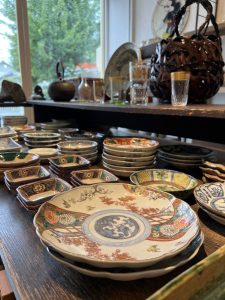今年も日泰寺フェスが開催されます。(愛知県名古屋市千種区姫池通 骨董買取 古美術風光舎)
2024.10.04
皆様こんにちは、スタッフYでございます。
まずはお知らせを。
今年も古美術風光舎のご近所
日泰寺にて
10月5日(土)、6日(日)
「日・タイ文化フェスティバル2024(日泰寺フェス)」が開催されます。
日泰寺境内において、たくさんのお店が出展し、さらにイベント会場ではムエタイやタイ舞踊などのパフォーマンスなど、日本にいながらタイの文化を楽しめる面白いフェスです。是非遊びにいらしてみてください。
日泰寺から弊店は徒歩5分ほどですので、是非古美術風光舎にもお立ち寄りください!。

さてさてここからは、本日のつぶやきとまいりましょう。
このところ大河ドラマの「光る君へ」にはまっておりまして。特に色鮮やかな十二単や束帯などの意匠をみることがとても楽しみなのですが、きっと、この衣装の色彩にもいろいろなメッセージや特徴があるのだろうな…と、薄々想像しながら、もしくは裏情報を探しながらみております。そんな主人公まひろはやはり紫式部ということで、名前の通り、衣装の所々に紫を使っていることが多いようです。そんな「隠れ紫」をよく探しております。
平安装束、得に十二単については様々な研究や情報があふれ、皆さま既に周知とは思いますが、それぞれの色に官位や状況、そしてもちろん季節によって色が違っているのですが、さらに色彩や柄や素材の違いで重ねた襲色目(かさねいろめ)と呼ばれるをも楽しんでいたようです。ここまでおしゃれにこだわることは、われわれ現代人、到底かなわないのですが、とはいえパーソナルカラー診断などは今流行っているところをみますと、どんな色を纏うのかは未来永劫、人間にとって気になるところなのでしょうね。
参考までに調べて見たのですが、平安装束のカラーコーディネートのポイントは3種類あるようです。
- 重色目
表の色と裏の色の組み合わせ。当時の絹は薄かったので裏地が透けたため複雑な色彩となり、バリエーションも豊富だったのでしょうか。 - 襲色目
いわゆる十二単のような重ね着で、重なる色彩のグラデーションを楽しむもの。一番目立つポイントでしょうか - 織りによるかさね色目
反物を織る段階で縦糸と横糸の色を変え、玉虫色の色彩を楽しんだようです。
こんなふうに公家たちは季節季節で色彩を暮らしの中で楽しんでいたようですね。そこに当時はさらにこれらに季節感を取り入れた配色が流行したようで、それらを襲色目(かさねいろめ)と言いますが、そのバリエーションの数がものすごく、いったい各季節に着物を何枚もっていたのか…などと焦ってきます。ですが、これが貴族の日常。「焦っている」といった自分の庶民具合だけが露わになっただけでした笑。
さらに、その「襲色目」(かさねいろめ)ですが、気になって調べて見ますとものすごい数でした笑。これは現代に伝わる秋のかさね色目のほんのごくごく一部なのですが、


和楽Webより
たとえば、「紅葉(もみじ)」と「青紅葉(あおもみじ)」。おなじ「紅葉」のキーワードが入っていても、高揚した紅葉なのかこれから紅葉していく紅葉なのかでも色が違ってきますし、そもそも紅葉を表す「赤」も少し違っていますよね。紅葉一つとっても異なる配色と景色を生み出し、それらをさらに重ね重ね衣裳で表現しているのですから、平安貴族たちの観察力の鋭さと、季節を愛でる心がいかに繊細だったのかが伺えしれます。
それに比べ、現代は季節も色もデザインも何の制約もなく好きなものを着ればいい時代のはずなのに、自分に至ってはマンネリコーデが日々を悩ましております。この秋のマンネリコーデ脱却にむけて、この無限に広がる「襲色目」(かさねいろめ)が、何かの参考になるかもしれない気がしてきましたので、早速帰って秋の洋服を引っ張り出してみいたいと思います。
それではごきげんよう。
Hello everyone, this is Staff Y.
Recently, I have been absorbed in the historical drama “Hikaru Kimi e” (To the Luminous Kimi). I am especially looking forward to seeing the colorful designs of the junihitoe (12-layered kimono) and sokutai (a ceremonial kimono worn over a kimono), and I imagine that there must be various messages or characteristics in the colors of the costumes… I watch the drama with my imagination, or while looking for information behind the drama. The main character, Mahiro, is also called Murasaki Shikibu, and as her name suggests, she often uses purple in various parts of her costumes. I often look for such “hidden purple.
There is a lot of research and information on Heian costumes, especially juni-hitoe, and I am sure everyone is already familiar with them, but it seems that people also enjoyed the “kasane-iro-me,” a color layered with different colors, patterns, and materials. We modern people can never be this particular about fashion, but judging from the popularity of personal color diagnosis, it is likely that people will always be interested in what colors they wear.
For reference, I looked into it and found that there are three types of color coordination points for Heian costumes.
Double-colored eyes
A combination of the color of the front and the color of the back. Silk was thin at that time, so the lining was transparent, resulting in complex colors and a wide range of variations.
Soushoku-keime (a color combination of two colors)
This is a layered dress like the so-called juni-hitoe, in which the gradation of colors is enjoyed. This is probably the most conspicuous point.
Kase-iro-me by weaving
The colors of the warp and weft threads were changed at the stage of weaving the fabric to enjoy the iridescent colors.
It seems that court nobles enjoyed the colors of the seasons in their daily lives. The number of variations was so great that one wonders how many kimonos they had for each season. But this is the daily life of aristocrats. But this is the daily life of an aristocrat, and only his “impatience” reveals how much of a commoner he is.
I was curious about this “kasane-iro-me,” but when I looked it up, I found a tremendous number of them. This is just a small part of the autumnal kasane-iro-me that have been handed down to the present day,
For example, “Momiji” and “Aomomiji. Even if the same keyword “Momiji” is used, the colors are different depending on whether the leaves are exuberant or just starting to turn red, and the “red,” which represents autumn leaves, is also slightly different. The red color for autumn leaves is also a little different. The fact that they created different color schemes and landscapes even for a single autumn leaf, and expressed them in layers and layers of costumes, shows how sensitive the Heian aristocrats were in their observation and love of the seasons.
In comparison, today, we should be able to wear whatever we like without any restrictions on season, color, or design, but for myself, I find myself in a rut every day. I have a feeling that this endlessly expanding “Kasane-iro-me” may be of some help to me in getting out of this autumn rut, so I would like to go home and pull out my autumn clothes.
Have a good day.
*******************
ご実家の整理やお片付けなどをされている方のご相談などが多くございます。
お片付けなどくれぐれもご無理のないようになさってくださいませ。
風光舎では古美術品や骨董品の他にも絵画や宝石、趣味のお品など様々なジャンルのものを買受しております。
お片付けをされていて、こういうものでもいいのかしらと迷われているものでも、どうぞお気軽にご相談下さいませ。
また風光舎は、出張買取も強化しております。ご近所はもちろん、愛知県内、岐阜県、三重県その他の県へも出張いたします。
なお、毎月21日の持込鑑定会では無料鑑定・買取・ご相談など、ご予約なしで承っております。
ご近所の皆さま、ご遠方のみなさまも、お気軽にお越しくださいませ。
まずは、お電話お待ちしております。
愛知県名古屋市千種区姫池通
骨董 買取【古美術 風光舎 名古屋店】
TEL052(734)8444
10:00-18:00 OPEN
#出張買取#骨董#古美術#骨董品#絵画#版画#茶道具#刀剣#彫刻

